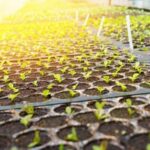Florida is a haven for vegetable gardening enthusiasts, with its diverse climate and rich agricultural history. In this article, we will delve into the world of Florida vegetable gardening month by month, exploring the unique characteristics of gardening in the Sunshine State. By following a month-by-month approach, gardeners can optimize their productivity and make the most of Florida’s varied growing conditions.
Gardening in Florida comes with its own set of challenges and advantages. From the tropical climate in the southern regions to the more temperate conditions in the north, each part of the state presents different opportunities for successful vegetable cultivation. By understanding these variations and tailoring their approach accordingly, gardeners can achieve abundant harvests throughout the year.
In each section of this article, we will focus on a specific month and provide valuable insights into the ideal vegetables to grow during that time. We will discuss various aspects such as soil preparation, watering techniques, companion planting, and pest control methods to ensure healthy growth. By practicing strategic planting techniques and utilizing suitable varieties for each season, Florida gardeners can maintain thriving gardens all year long.
Whether you are a novice gardener or have years of experience under your belt, this article will serve as a comprehensive guide to maximize your success in creating a bountiful and sustainable Florida vegetable garden. Join us on this journey as we explore the intricacies of gardening month by month in one of America’s most fertile states.
January
In Florida, January marks the beginning of a new year and an exciting time for vegetable gardening. With mild temperatures and plenty of sunshine, this month provides the perfect conditions for planting a variety of vegetables that thrive in the state’s unique climate. By kickstarting your garden in January, you can enjoy bountiful harvests throughout the year.
When it comes to choosing vegetables for January planting in Florida, there are several options that flourish during this time. Beetroot is a popular choice as it thrives in cooler temperatures and can be harvested within 60 days. Cabbage is another great option, offering nutritional benefits and versatility in cooking. Carrots also do well in Florida’s winter climate and can be harvested when they reach their optimal size.
To ensure successful growth, proper soil preparation is essential. Start by testing the soil’s pH levels and making any necessary adjustments to create an ideal environment for your chosen vegetables. It’s also important to water your plants regularly but avoid over-watering, as excessive moisture can lead to root rot or other diseases. Additionally, pay attention to temperature considerations by providing protection for your crops during any unexpected dips in temperature.
| Vegetable | Days to Harvest | Optimal Soil pH |
|---|---|---|
| Beetroot | 60-70 days | 6-7 |
| Cabbage | 65-80 days | 6-7.5 |
| Carrots | 60-80 days | 5.8-7 |
By following these tips and planting the right vegetables in January, you can set your Florida vegetable garden up for success throughout the year. Remember to monitor your plants closely, provide adequate care, and make any necessary adjustments based on the unique conditions of your specific region within the state. Happy gardening.
February
February Vegetables for Florida Gardening
In the month of February, Florida gardeners have the opportunity to embrace the love month by nurturing and growing a variety of tender plants. These vegetables thrive in the unique climate of Florida during this time, providing an abundance of fresh produce. Some of the recommended vegetables for February planting in Florida include lettuce, kale, and broccoli.
The Benefits of Companion Planting
One effective technique to enhance growth and maximize productivity in a Florida vegetable garden is through companion planting. This method involves planting different species or varieties next to each other that benefit one another. In February, incorporating companion plants can be especially beneficial for tender plants like lettuce, kale, and broccoli. For example, planting onions alongside lettuce can help repel insects that may harm the lettuce leaves.
Additionally, basil is known to improve the taste and growth of tomatoes when planted nearby. By implementing companion planting techniques in February, Florida gardeners can create a thriving ecosystem within their vegetable gardens.
Tips for Nurturing Delicate Plants
Tender plants require special care to ensure their successful growth in a Florida garden during February. Proper watering and temperature considerations are crucial factors to keep in mind. These plants often prefer slightly cooler temperatures and require consistent moisture in the soil.
To maintain ideal soil moisture levels, it is recommended to mulch around the base of delicate plants like lettuce, kale, and broccoli. This helps retain moisture while also preventing weed growth. Additionally, monitoring soil drainage and avoiding overwatering is essential for preventing fungal diseases.
By being mindful of these tips and actively nurturing delicate plants throughout February, Florida gardeners can enjoy a flourishing vegetable garden that yields an abundant harvest.
March
As March arrives in Florida, gardeners can rejoice in the anticipation of a bountiful harvest. The spring season brings forth a range of vegetables that are ideally suited for planting during this time, ensuring a fruitful and vibrant garden. With optimal sun exposure and effective pest control methods, gardeners can enjoy the rewards of their well-tended gardens.
When it comes to selecting vegetables for planting in March, there are several popular options that thrive in Florida’s climate. Tomatoes, peppers, and cucumbers are excellent choices that flourish during this time. These warm-season crops require full sun exposure for at least six to eight hours per day. It is important to provide them with well-drained soil enriched with organic matter to promote healthy growth.
Pest control is crucial during the spring season as various insects become more active. To protect your vegetable garden from pests such as aphids or caterpillars, consider implementing natural pest management methods like companion planting or using organic pest control products. Additionally, regular monitoring and inspection of your plants will help identify any signs of insect damage early on, allowing you to take necessary measures promptly.
By tending to your vegetable garden diligently in March, you can ensure a successful growing season and an abundant harvest later on. The rewards of your efforts will be evident as you savor the fresh flavors of homegrown tomatoes, peppers, and cucumbers straight from your own backyard. So roll up your sleeves and spring into action – March is the perfect time to reap the delightful rewards of a well-tended garden in Florida.
April
April is an exciting time for Florida vegetable gardeners as the weather warms up and plants begin to thrive. This month presents the perfect opportunity to unleash the full potential of your garden and enjoy a bountiful harvest. By implementing strategic planting and spacing techniques, you can maximize productivity and create a flourishing oasis in your backyard.
One key aspect to consider in April is planting vegetables at the appropriate spacing intervals. Adequate spacing allows plants to receive sufficient sunlight, air circulation, and nutrients from the soil. Creating a planting plan or utilizing companion planting methods can help optimize your garden‘s productivity. For example, interplanting herbs like basil with tomatoes not only maximizes space but also provides natural pest control benefits.
To truly understand the possibilities of a well-tended Florida vegetable garden in April, let’s take a look at some success stories from dedicated gardeners across the state. Sarah from Miami successfully grows zucchini by providing trellises for vertical growth, which saves space and increases yield.
Frank from Tampa ensures his eggplants thrive by mulching around their base with organic material to retain moisture and suppress weed growth. These examples demonstrate how tailored techniques can unlock the hidden potential of your April garden.
In terms of recommended vegetables for April in Florida, options abound. Zucchini is a versatile vegetable that flourishes during this time, yielding an abundance of tasty fruit suitable for various culinary creations. Eggplant is another excellent choice that offers unique flavors while thriving in warm weather conditions. Additionally, herbs such as basil, cilantro, and mint are ideal for adding fresh flavors to your dishes or refreshing beverages.
Unleash the vibrant potential of your Florida vegetable garden this April by embracing strategic planting techniques, drawing inspiration from successful gardeners across the state, and experimenting with diverse vegetables suited for this time of year. With diligence and care, you’ll be rewarded with a flourishing garden that provides fresh and nutritious produce for your table.
May
Understanding the Challenges
Florida’s intense summer heat poses a significant challenge for vegetable gardeners in May. The combination of high temperatures and humidity can lead to dehydration and stress for plants, impacting their growth and productivity. Therefore, it is crucial to prepare your garden for the upcoming months and develop strategies to ensure your plants thrive despite the harsh conditions.
One of the primary concerns during this time is maintaining adequate moisture levels in the soil. The scorching heat can quickly dry out the soil, making it essential to implement proper irrigation techniques. Consider using drip irrigation or soaker hoses to deliver water directly to the plant’s root zone, reducing wastage due to evaporation. Additionally, applying a layer of organic mulch around your plants can help conserve moisture by reducing evaporation and suppressing weed growth.
Providing Shade and Reducing Heat Stress
In Florida’s intense heat, providing shade can be instrumental in protecting your vegetables from sunburn and excessive heat stress. Consider installing shade cloths or using temporary structures like umbrellas or shading devices to filter sunlight during the hottest parts of the day. Be mindful not to completely block out all light since plants still require sunlight for photosynthesis.
Another effective method to reduce heat stress is by implementing mulching techniques. Applying a layer of organic mulch around your plants helps insulate the soil, keeping it cooler during hot weather. This insulation prevents excessive temperature fluctuations that can be detrimental to plant health.
Heat-Tolerant Vegetable Options
Despite the challenges presented by May’s intense summer heat, there are still several vegetable options that thrive in Florida during this time. These heat-tolerant vegetables have adapted to withstand high temperatures and continue producing bountiful harvests throughout summer.
One such option is okra, a versatile vegetable that loves warmth and thrives in Florida’s climate. Plant okra seeds about 1 inch deep in well-drained soil and provide them with ample water. With regular watering, you can enjoy a continuous supply of tender okra pods throughout the summer.
Sweet potatoes are another excellent choice for Florida gardens during May. These heat-loving plants require full sun and well-drained soil. Plant sweet potato slips or cuttings about 12 inches apart and ensure they receive consistent moisture. As the vines grow, they will create lush ground cover that helps suppress weeds and conserve soil moisture.
Swiss chard is a nutritious leafy green that withstands summer heat exceptionally well. Plant seeds or transplants in partial shade or provide afternoon shade to protect them from intense sunlight. Swiss chard prefers consistently moist soil, so regular watering is necessary to maintain its vigor and prevent wilting.
By implementing these strategies and selecting heat-tolerant vegetables, your garden can thrive despite Florida’s intense summer heat. With proper care and foresight, you can enjoy a resilient and productive vegetable garden throughout the summer months.
June
June is an exciting time for Florida gardeners as they begin to reap the rewards of their hard work and enjoy the bountiful harvests from their vegetable gardens. However, it is crucial to continue proper maintenance and care to ensure the health and productivity of the garden throughout the summer season. In this section, we will explore tips and techniques for maintaining and harvesting in June.
One of the most important aspects of maintaining a thriving garden in June is proper watering. Florida’s hot summers can be challenging for plants, so it is essential to provide sufficient water while avoiding overwatering.
Deep watering early in the day will help deliver moisture to the roots, while allowing the foliage to dry out, reducing the risk of fungal diseases. Regularly inspect plants for signs of water stress, such as wilting or yellowing leaves, and adjust your watering schedule accordingly.
Mulching is another vital practice for maintaining a healthy garden during June. Applying a layer of organic mulch around plants helps regulate soil temperature, retain moisture, suppress weed growth, and prevent soil erosion. Additionally, mulch provides a protective barrier against pests and disease-causing organisms that may splash onto plants during heavy rains. Common types of mulch for Florida gardens include straw, pine straw, wood chips, or compost.
In terms of harvesting in June, many delicious vegetables are ready for picking during this month. Watermelon is a popular choice that thrives in Florida’s warm climate. Look for fruits with a dull skin color on top and a creamy yellow bottom-the classic sign that they are ripe and ready to enjoy. Another delight to harvest in June is cantaloupe; they should easily detach from the vine when gently tugged and have a fragrant aroma indicating ripeness.
Bell peppers are also abundant in June gardens. When bell peppers reach their mature size-usually about 3-4 inches in diameter-they can be harvested. Choose peppers with firm flesh and a glossy, smooth skin to ensure the best flavor. Harvesting them regularly will help encourage continuous production throughout the summer.
By maintaining proper care and harvesting the ripe produce in June, Florida gardeners can fully savor the fruits of their labor. Remember to continue watering diligently, mulch the soil to conserve moisture and suppress weeds, and enjoy the delicious flavors of freshly harvested vegetables. Gardening in Florida is a year-round endeavor, and June offers plenty of opportunities to experience the joys of a fruitful garden.
July
Gardening in Florida during the month of July can pose significant challenges due to the intense heat and humidity. However, with proper care and strategic planning, it is still possible to maintain a thriving vegetable garden. This section will discuss coping strategies and essential care tips for midsummer gardens in Florida.
One of the key challenges faced by gardeners in July is combatting the intense heat. Providing shade for your plants becomes crucial during this time. Consider using shade cloths or creating temporary structures using lightweight materials to provide relief from direct sunlight.
It is also essential to monitor soil moisture levels closely, as high temperatures can cause rapid evaporation. Implementing an efficient irrigation system that delivers water directly to the roots of the plants will help ensure they receive adequate hydration.
Proper watering techniques are essential for the health of your midsummer garden. Water your plants deeply and less frequently to encourage deep root growth and withstand dry spells. Mulching around your plants can also help retain moisture in the soil, reduce weed growth, and regulate soil temperature. Organic mulch materials such as straw or wood chips work well in retaining moisture while adding nutrients to the soil over time.
During July, it is important to choose heat-resistant vegetables that can withstand the challenging conditions in Florida. Sweet corn, beans, and summer squash are excellent options as they thrive in high temperatures and require minimal water once established. These vegetables have adapted well to Florida’s climate and provide a bountiful harvest during this time.
By implementing coping strategies like providing shade, efficient watering techniques, and selecting heat-tolerant vegetables, you can beat the heat and enjoy a successful midsummer garden in Florida during July. With careful planning and ongoing care, you can continue to nurture your vegetable garden month by month for year-round success in Florida’s unique growing conditions.
Conclusion
In conclusion, nurturing your Florida vegetable garden month by month is the key to achieving year-round success. The unique growing conditions of the state offer a rich world of opportunities for gardeners to explore and maximize productivity. By following the recommendations provided in each month’s guide, you can create a flourishing and sustainable garden that brings you bountiful harvests throughout the year.
Gardening month by month allows you to adapt your planting and care strategies according to the specific needs of each season. By understanding the optimal vegetables for each month, as well as the recommended soil preparations, watering techniques, and temperature considerations, you can ensure the health and growth of your plants.
Whether it’s kickstarting the year with beets, cabbage, and carrots in January or preparing for intense summer heat with okra, sweet potatoes, and Swiss chard in May, each month presents its own opportunities for success.
It is important to remember that these recommendations can be tailored to your specific region within Florida. The state’s diverse growing conditions from North to South provide unique challenges and advantages. Experiment with different varieties of vegetables, incorporate companion planting techniques for enhanced growth, and learn from the success stories of dedicated Florida gardeners who have unleashed the full potential of their gardens.
So go ahead and take pride in nurturing your own fruitful Florida vegetable garden. By implementing these monthly recommendations and adapting them to your region’s climate, you can enjoy a continuous supply of fresh produce year-round while experiencing the joy and satisfaction that comes with sustainable gardening practices. Happy gardening.
Frequently Asked Questions
What is the best month to plant vegetables in Florida?
The best month to plant vegetables in Florida is typically September. This is because the weather begins to cool down slightly, providing a more favorable temperature for planting. Additionally, rainfall tends to increase during this time, which helps to provide sufficient moisture for the growing plants.
September also allows enough time for the vegetables to mature before the arrival of colder winter temperatures. Certain vegetables that thrive in the fall season in Florida include tomatoes, peppers, beans, cucumbers, and herbs like basil and parsley.
In what month do you plant a garden in Florida?
In Florida, gardens are usually planted in late summer or early fall. This timing allows the garden to take advantage of cooler temperatures and higher rainfall levels that occur during this period.
Planting a garden in Florida too early can result in heat stress for the plants, while planting too late may not leave enough time for them to fully mature before cold winter temperatures arrive. By starting a garden in late summer or early fall, you give your crops ample time to grow and develop into healthy plants that will eventually yield a bountiful harvest.
What vegetables can you grow in the fall in Florida?
Fall is an excellent season for growing vegetables in Florida due to its milder temperatures and increased chances of rainfall compared to the summer months. Some popular vegetables that can be grown during this time include broccoli, cabbage, Brussels sprouts, kale, cauliflower, lettuce, spinach, radishes, and carrots.
These cool-season crops thrive under the conditions present during fall in Florida as they prefer cooler temperatures and shorter daylight hours. By planting these vegetables in the fall months when humidity levels start dropping and days become shorter, you can enjoy fresh homegrown produce throughout autumn and even into winter depending on your specific location in Florida.

If you’re looking to get into vegetable gardening, or are just looking for some tips on how to make your current garden better, then you’ve come to the right place! My name is Ethel and I have been gardening for years. In this blog, I’m going to share with you some of my best tips on how to create a successful vegetable garden.





